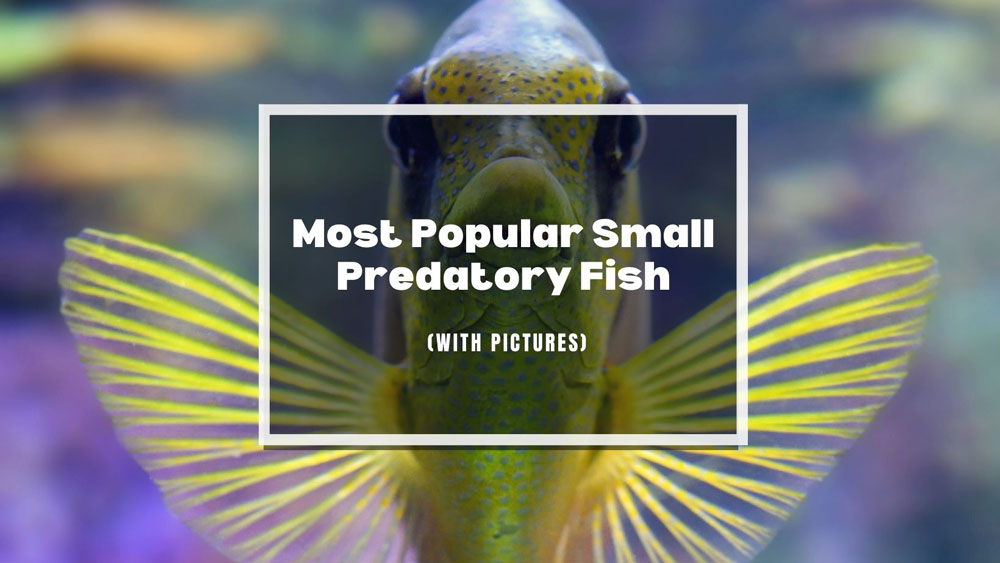Are you the type of fearless fish keeper that is fascinated by strength, speed, and the interesting feeding behaviors of a predatory fish? Do you want to add a little excitement and exotic to your aquarium? If so, then you are in luck because there are many different types of predatory fish that make great pets.
Since they need necessary stimuli to trigger and train their natural behaviors, ample space is a must for most predatory fish.
But most people don’t realize that there are also small predatory fish that can be kept in small to medium-sized aquariums. These small predators are just as fascinating to watch as their larger counterparts and can add a whole new level of interest to your aquarium.
This list will help you choose the best small predatory fish for your aquarium.
Small Predatory Fish (Animal) for Small Aquariums (10 to 15 Gallons)
As any aquarium owner knows, most fish are opportunistic predators, and they will gladly consume whatever creature can fit into their mouths, let alone a piscivore – a true predatory fish that eats primarily fish in the wild.
Any piscivore that will take live fish needs at least a 30 gallons tank; they can easily grow out of these small aquariums.
But don’t despair – there are still a few aquatic insectivores predators of small aquatic insects, including larvae, snails, etc., that can be kept in a 10 gallons aquarium.
Betta
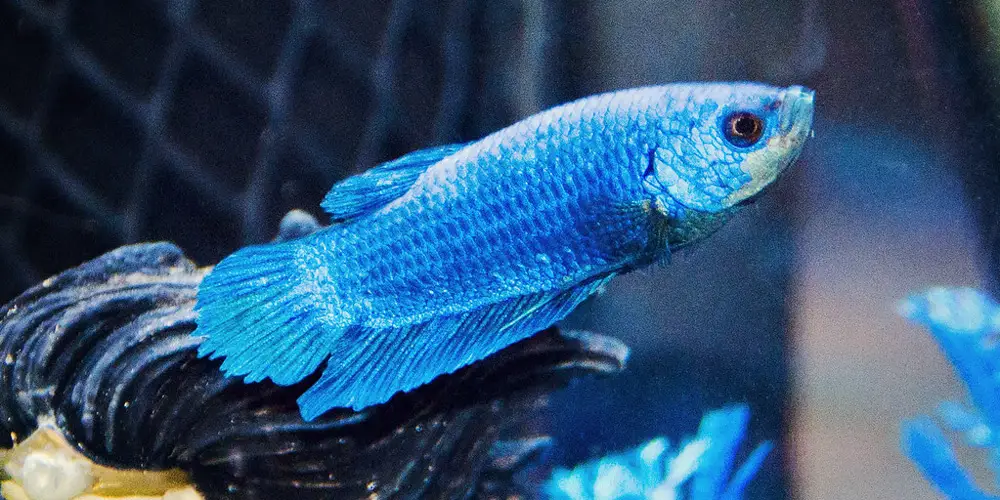
The first on our list of small predatory fish is the most popular Betta or Siamese fighting fish. Bettas are best known for their long beautiful fins, small size, big personalities, and aggressive temperament.
Bettas are carnivores or insectivores in the wild and feed on small insects, larvae, and zooplankton. To make your Betta like a voracious predator, you can keep it with white clouds, ghost shrimp, or cherry shrimp.
| Scientific Name: | Betta splendens |
| Common Name: | Siamese Fighting Fish |
| Origin: | Thailand |
| Max Size: | 2 to 3 inches |
| pH: | 6.5-7.5 |
| Temperature: | 75°-81°F (23.8°-27.2°C) |
| KH: | 3-5 dKH |
| Diet: | Omnivorous |
Pea Puffers (Carinotetraodon travancoricus)
Pea puffers, also known as Indian dwarf puffer, pygmy puffer, and Malabar puffer, are the coolest and smallest puffers you can keep in a smaller aquarium. You can keep two to three pea puffers in a 10-gallon tank and three to five fish in a 15-gallon tank.
Like most puffers, these fish are carnivores. In the wild, they eat shellfish, small crustaceans, mollusks, and worms.
In the aquarium, they don’t accept dried fish foods. So, you have to provide them with a diet of frozen or live foods such as brine shrimp, bloodworms, daphnia, little pest snails, and tubifex worms.
| Scientific Name: | Carinotetraodon travancoricus |
| Common Name: | Dwarf Puffer, Pea Puffer |
| Origin: | India |
| Max Size: | 1 1/2 inches |
| pH: | 6.8 – 8.0 |
| Temperature: | 72 – 82°F (22 – 28°C) |
| KH: | 5-25 dKH |
| Diet: | Carnivorous |
Budgett’s Frog (Lepidobatrachus laevis)
If you’re not committed to looking for a fish for a 10-gallon tank, a single adult Budgett’s frog, one of the most sedentary small predators, is a good option. They are known for their voracious appetites and will consume any living creature smaller than them, including the best staple diet – appropriately sized crickets and nightcrawlers.
You need to remove their legs when you’re feeding crickets as they might come out in the frog’s waste. You should also cut the nightcrawlers into small pieces.
Watching a Budgett’s frog hunt is fun, and you’ll be rewarded with an amusing expression as the frog appears to smile when eating. But don’t overfeed them.
| Scientific Name: | Lepidobatrachus laevis |
| Common Name: | Budgett’s frog |
| Origin: | South America |
| Max Size: | 4 to 5 inches |
| pH: | 7.0 – 8.0 |
| Temperature: | 24 -25 °C (75.2-77°F) |
| KH: | 8-25 dKH |
| Diet: | Carnivorous |
Small Predatory Fish for Mid-sized Fish Tanks (20 to 40 Gallons)
Any tank size ranging from 20 to 40 gallons is best for people who are new to aquariums. These mid-sized fish tanks have a sufficient volume that will offer a stable environment, and they’re not so big that they’re overwhelming.
Of course, they give you more options for stocking your tank with small predatory fish.
Predatory fish for 20 to 29 Gallons Tanks
If you’re limited to a tank smaller than 30 gallons, these are two of the best predatory fish species for you:
South American Leaffish (Monocirrhus polyacanthus)
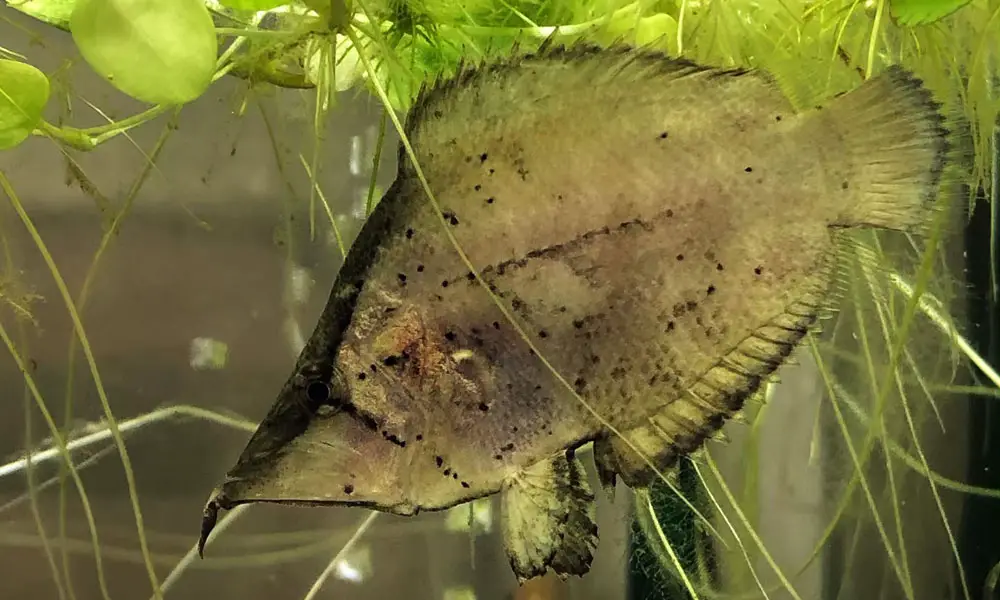
The South American Leaffish, or Amazon Leaffish, is one of the most unique-looking small predatory fish. As its name suggests, this species looks like a dead leaf floating in the water. When fully grown, they only reach a maximum size of 3 inches (8 cm) and a total length of 3.9 inches (10 cm).
Despite their small size, they are voracious predators. In the wild, young feed on invertebrates while adults mostly eat small fish. In the home aquarium, you must provide at least three feeder guppies per day to meet the dietary needs of a single adult South American Leaffish.
| Scientific Name: | Monocirrhus polyacanthus |
| Common Name: | South American Leaffish, Amazon Leaffish |
| Origin: | South America |
| Max Size: | 3.9 inches (10 cm) |
| pH: | 5.0-6.8 |
| Temperature: | 73 – 84°F (23-29°C) |
| KH: | 1-10 dH |
| Diet: | Carnivorous |
Axolotl (Ambystoma mexicanum)

The Axolotl (Ambystoma mexicanum) is a permanently aquatic salamander. They are popular pets because of their unusual appearance and ability to regenerate lost body parts.
In the wild, axolotls eat a variety of small prey, including worms, insects, small fish, and other small aquatic creatures. In the aquarium, they will accept most live foods such as earthworms, brine shrimp, tubifex worms, as well as commercial fish pellets.
Make sure the tank has a tight-fitting lid as they are good escape artists.
| Scientific Name: | Ambystoma mexicanum |
| Common Name: | Axolotl |
| Origin: | South America |
| Max Size: | 9 inches (23 cm) |
| pH: | 6.5-8.0 |
| Temperature: | 60-70°F (15-23°C) |
| KH: | 7-14 dH |
| Diet: | Carnivorous |
Author note: A 20-gallon long (30″ x 12″ x 12″) is always going to be better than a 20-gallon high (24″ x 12″ x 16″) for most fish as it offers a larger footprint.
Small Predatory fish for 30 to 40 Gallons Tanks
As the tank size increases, you have more options when it comes to stocking your aquarium with predatory fish, including these piscivores.
African Butterflyfish (Pantodon buchholzi)
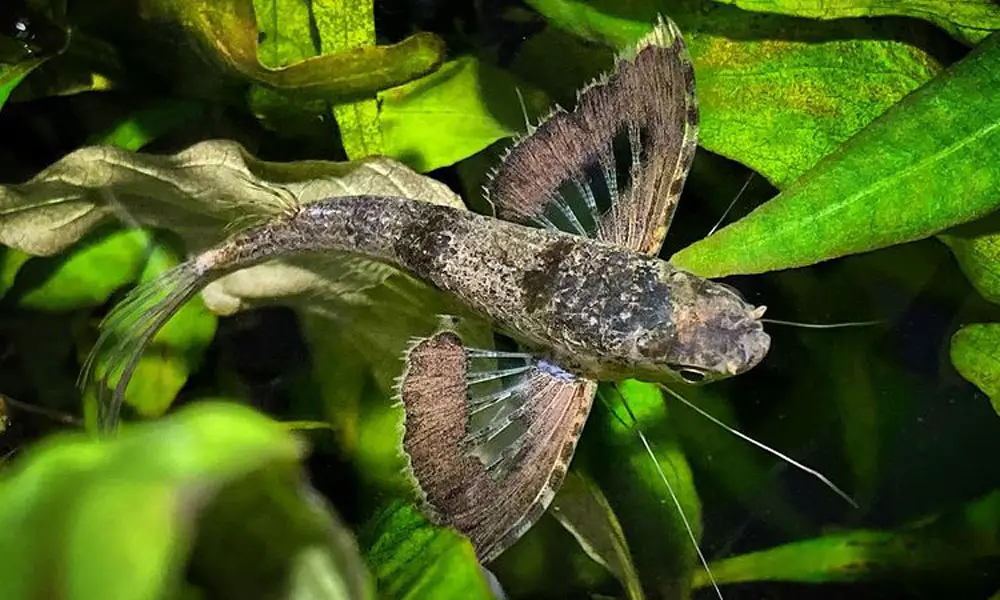
The African Butterfly Fish has an interesting-looking appearance. They are found in large bodies of water across Africa, where they feed on small fish and insects that live near the surface of the water.
In the aquarium, they will not accept prepared food, so you must provide them with a steady diet of live foods such as brine shrimp, Daphnia, small fish, and live crickets. They really enjoy the crickets, either fry or adults, so feel free to offer them as a treat or as good staples.
Like the Axolotl, a lid is also essential as they are excellent jumpers.
| Scientific Name: | Pantodon buchholzi |
| Common Name: | African Butterfly Fish |
| Origin: | West Africa |
| Max Size: | 5 inches |
| pH: | 6.0-7.5 |
| Temperature: | 73-86°F (23-30°C) |
| KH: | 5-15 dKH |
| Diet: | Carnivorous |
Pike Killifish (Belonesox belizanus)

The pike topminnow (Belonesox belizanus), widely known as pike killifish, is actually a livebearer. But it’s a highly skilled predator due to its well-developed upper jaw that allows it to take down larger prey.
Being a piscivore, adult pike killifish feeds largely on mosquitofishs, platies, and swordtails while juveniles prey on other juvenile fishes. Cannibalism is reported in this species.
In the aquarium, they are picky eaters. It’s best to feed them live foods such as platies or young guppies.
| Scientific Name: | Belonesox belizanus |
| Common Name: | Pike topminnow |
| Origin: | North and Central America |
| Max Size: | 6 inches |
| pH: | 7.5-8.0 |
| Temperature: | 25 – 30 °C (77 – 86°F) |
| KH: | 20-30 dKH |
| Diet: | Carnivorous |
Golden Puffer (Auriglobus modestus)
The Golden Puffer (Aka Avocado puffer) is a small, beautiful, fast-moving fish that is found in medium-sized rivers and streams in Asia. They get their name from their stunning yellow coloration. When fully grown, they reach a maximum size of 4.5 inches (11.4 cm).
In their natural habits, they are omnivores that feed on a variety of small prey such as insects, mollusks, seeds, and minnows. You can’t rely on aquarium flakes and pellets. As with all puffers, they should be fed with live or frozen meaty foods.
| Scientific Name: | Auriglobus modestus |
| Common Name: | Golden Puffer, Avocado Puffer, Bronze Puffer |
| Origin: | Asia |
| Max Size: | 4.5 inches |
| pH: | 6.0-7.8 |
| Temperature: | 74.0 to 82.0° F (23.3 to 27.8° C) |
| KH: | 4-18 dKH |
| Diet: | Carnivorous |
Small Predatory Fish for a 55 gallons Fish Tank
Perhaps the most popular size for aquariums is the 55-gallon tank. This size is large enough to accommodate a wide variety of fish, yet it is small enough to fit in most homes.
Here are a few options if you’re looking for predatory fish for your 55-gallon tank.
Leopard Bushfish (Ctenopoma acutirostre)
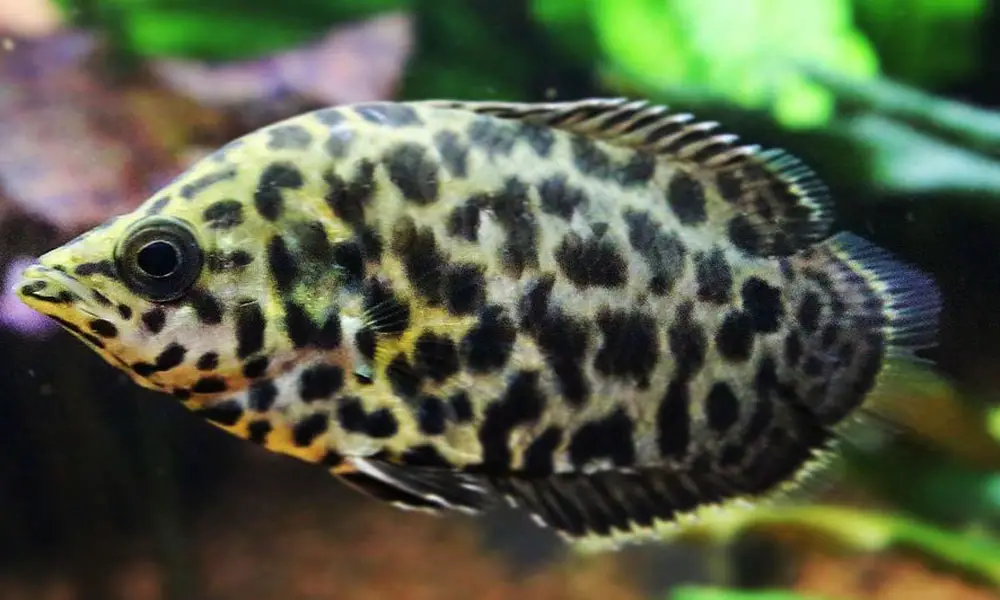
The Leopard Bushfish is a stunning freshwater fish that is endemic to the Congo River basin in Africa. They have a unique leopard-like pattern on their bodies and can grow up to 8 inches (20 cm) in the wild, while in captivity, they usually max out at 6 inches (15 cm).
In the wild, their diet consists of small fish, crustaceans, and insects. In captivity, you can feed them live, frozen foods such as brine shrimp, Daphnia, or small fish. However, they will learn to accept sinking pellets, so don’t be afraid to offer those as well.
| Scientific Name: | Ctenopoma acutirostre |
| Common Name: | Leopard Bushfish |
| Origin: | Central Africa |
| Max Size: | 6 inches |
| pH: | 6.5-7.5 |
| Temperature: | 70°F to 82°F (20°C to 28°C) |
| KH: | 6-20 dKH |
| Diet: | Carnivorous |
Red Wolf Fish (Erythrinus erythrinus)

The red wolf fish, scientifically known as Erythrinus erythrinus, is a small Erythrinidae fish found in the Orinoco and Amazon river basins of South America. They can grow up to 8 inches (20cm) in length.
In their natural habitat, they are predators that will eat anything they can fit into their mouths, including other small fish, insects, and crustaceans. In the home aquariums, they can be weaned onto frozen foods.
| Scientific Name: | Erythrinus erythrinus |
| Common Name: | Red Wolf Fish |
| Origin: | South America |
| Max Size: | 7.9 inches |
| pH: | 5.5-7.5 |
| Temperature: | 72-79°F (22-26°C) |
| KH: | 2-25 dKH |
| Diet: | Carnivorous |
Dwarf Pike Cichlids (Crenicichla compressiceps)
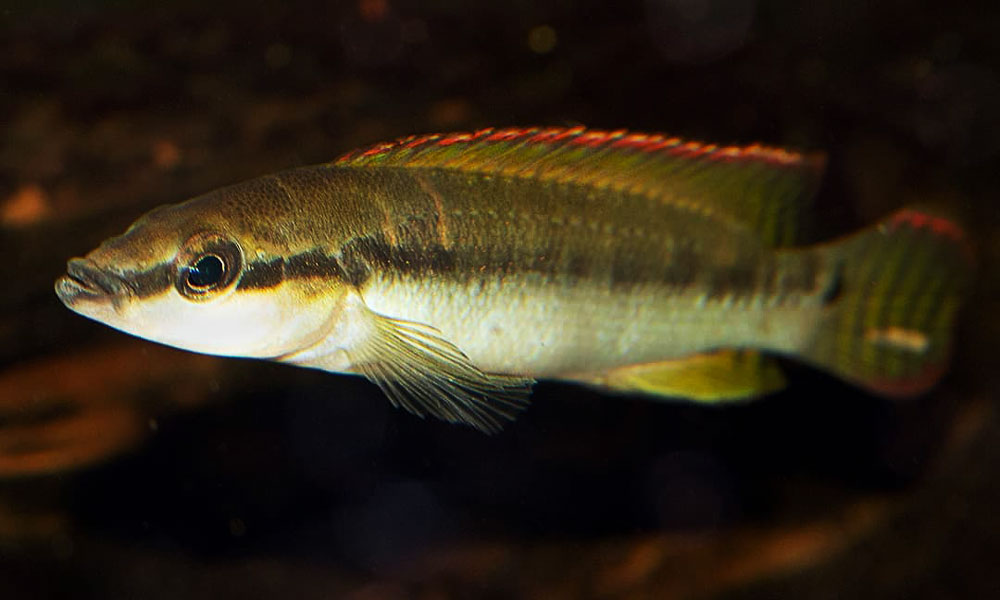
Pike Cichlids are really starting to pick up steam in the aquarist community, and the Dwarf Pike Cichlids are one of the smallest and most peaceful species in this group.
Despite their small size, they should be kept in large groups of at least 10 individuals; hence the minimum tank size would be a 55-gallon aquarium.
Like most other species of its genus, these fish are micropredatorfish that feed on insects and small crustaceans in the wild. They will readily accept frozen krill, bloodworms, and brine shrimp in captivity.
| Scientific Name: | Crenicichla compressiceps |
| Common Name: | Red Wolf Fish |
| Origin: | South America |
| Max Size: | 3.9 inches |
| pH: | 5.0 to 6.8 |
| Temperature: | 75 to 81°f (24 to 27°c) |
| KH: | 2-8 dKH |
| Diet: | Carnivorous |
Closing Thoughts
As you can see, there is a variety of small predatory fish that can do well in medium-sized tanks. Some are quite popular, and others are a bit more obscure.
But one thing is for sure, these fish can add some excitement to your aquarium and provide plenty of opportunities for you to watch them hunt down their prey.
We know the list is not exhaustive, so please feel free to add your favorite small predatory fish in the comments below. We will update the list periodically.
